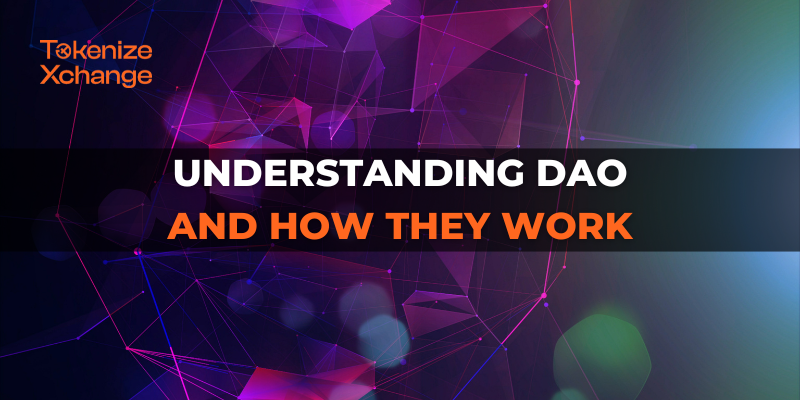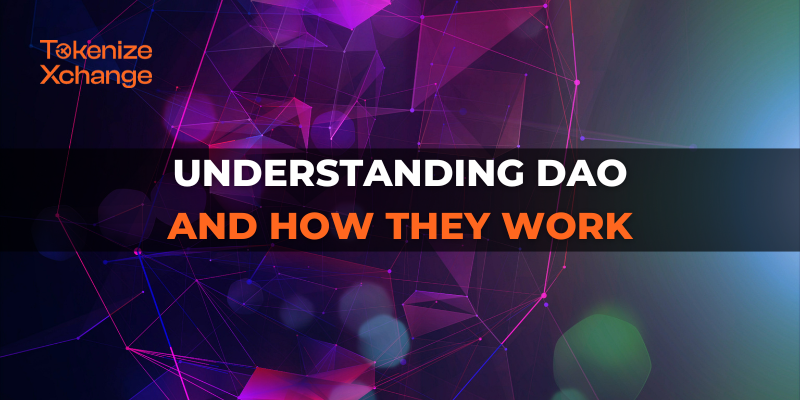
Decentralized Autonomous Organizations (DAOs) have emerged as a groundbreaking concept at the intersection of blockchain technology, cryptocurrencies, and decentralized governance. DAOs represent a radical shift in the way organizations operate, enabling collective decision-making and resource allocation without traditional hierarchical structures.
What is a DAO?
A DAO, or Decentralized Autonomous Organization, is a digital organization or entity that operates on a blockchain or distributed ledger technology. Unlike traditional organizations with centralized hierarchies and decision-making structures, DAOs are designed to function autonomously and democratically through the use of smart contracts and token-based governance.
How do DAOs work?
DAOs operate at their core by leveraging blockchain technology to enable collective decision-making, financial transactions, and resource allocation. Below is a detailed breakdown of the functioning of DAOs:
- Smart Contracts: Think of these as computer programs with built-in rules. They run automatically and carry out actions when specific conditions are met. For example, they can count votes or release funds without needing a person to do it.
- Token Allocation: To be part of a DAO, you need special digital coins called tokens. These tokens show that you have a say in decisions or ownership in the organization. You can get tokens by buying them, contributing to the organization’s funds, or earning them through participation.
- Voting Mechanisms: DAOs have different ways of voting, like in elections. You can vote based on how many tokens you own. Some DAOs use more complicated systems to make sure voting is fair.
- Proposal Submission System: DAOs let anyone suggest ideas or plans. These ideas can be about spending money, changing rules, or starting new projects. Proposals have all the details, like what the idea is and how much money it needs.
- Designated Voting Period: When there’s a proposal, there’s a set time for everyone to decide if they agree or not. This way, everyone has time to think about it and vote.
- Execution of Decisions: If enough people agree with a proposal during the voting time, it happens automatically. For example, if a proposal asks for money, the computer program sends the money where it’s supposed to go.
- Transparency through Blockchain: Everything that happens in a DAO is written down on a public record called the blockchain. This makes sure that everyone can see what’s going on and that no one cheats.
- Immutable Governance Rules: DAOs usually make it hard to change their rules once they’re set. This helps keep things steady and stops anyone from changing rules to their advantage.
- Inclusivity: DAOs are open to anyone with tokens. They’re more open to new people compared to regular organizations that might have strict rules for joining.
Key Components of DAO
- Smart Contracts: These automate DAO operations and enforce rules.
- Tokens: They represent ownership and voting rights in the DAO.
- Voting Methods: Different methods are used to reach consensus on proposals.
- Proposal System: Members can submit proposals for consideration.
Key Characteristics of DAO
- Smart Contracts: Picture these as digital rulebooks. When specific conditions are met, these rulebooks automatically execute actions, such as voting on important matters.
- Tokens: In DAOs, individuals own digital coins called tokens. These tokens grant them voting rights and decision-making power in the organization.
- Voting: Members use their tokens to cast votes on proposals, and the more tokens you have, the more weight your vote carries. Different voting methods are used, ranging from simple majority to more complex systems.
- Proposals: Anyone within the DAO can suggest ideas or plans, whether it’s about spending money, changing rules, or starting new projects.
- Decision Time: There’s a set timeframe for members to review and vote on proposals. They examine the proposals and decide whether they agree or disagree.
- Automatic Actions: If a proposal gains sufficient support during the voting period, it automatically takes effect. For instance, if a proposal requests funds, the system sends the money to the specified destination.
- Transparency: Every action and decision is recorded on a public ledger known as the blockchain, ensuring transparency and openness.
- No Changing the Rules: DAOs typically establish rules that are difficult to modify once in place, providing stability and preventing rule manipulation.
- Everyone’s Welcome: DAOs are open to anyone holding tokens, making them more inclusive than traditional organizations.
- Security: While they are secure, DAOs can encounter issues, particularly with their computer programs, necessitating strong security measures.
- Democracy: DAOs aim for fair decision-making, where votes correlate with token ownership.
- Trustless: Trust in a central authority isn’t required because everything is governed by computer programs and the blockchain.
- Open Source: Many DAOs share their code with the public, allowing anyone to inspect and contribute to their improvement.
- Accountability: Transparency and token-based rules help ensure that everyone adheres to the established guidelines.
In summary, DAOs leverage blockchain technology, smart contracts, and token-based governance to create decentralized, transparent, and inclusive organizations. These organizations operate autonomously, relying on the collective intelligence and participation of their members to make decisions and execute actions. Understanding the intricate interplay of their key components and characteristics is crucial for grasping the revolutionary potential of DAOs across various industries.
